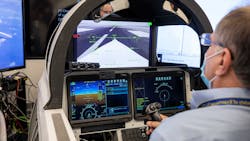Civilian and military aircraft get avionics upgrades
NASHUA, N.H. - Innovation never stops. In new and legacy aircraft, upgraded avionics - including communications, navigation, and flight control systems - can make a world of difference for pilots.
This spring, a number of industry heavyweights announced they had been selected to provide new avionics technology to helicopters, civilian and military aircraft, and even an experimental supersonic jet.
In May, Collins Aerospace in Cedar Rapids, Iowa, announced that the Raytheon Technologies business had been selected by Lockheed Martin to NASA’s X-59 Quiet SuperSonic Technology (QueSST) aircraft.
The X-59 research aircraft presented a unique avionics challenge for Collins Aerospace as the supersonic jet has no forward-looking windows for pilots to look through.
"The X-59 is expected to create a noise about as loud as a car door closing instead of a sonic boom when it breaks the sound barrier," explains Dave Schreck, vice president and general manager for Military Avionics and Helicopters at Collins Aerospace. "This aircraft has the ability to shape the future of supersonic travel and our avionics are helping make this revolutionary aircraft a reality. We’re excited as we count down the days until we see it fly."
NASA’s eXternal Vision System will allow X-59 pilots to safely navigate the skies by using a 4K monitor to display images from two cameras outside the aircraft combined with terrain data from an advanced computing system. By jointly developing software applications side-by-side with Lockheed Martin Skunk Works and NASA, Collins Aerospace was able to provide an optimized avionics solution that includes the company’s award-winning touchscreen primary flight displays with tailored multi-function windows, head-up display (HUD) symbology, synthetic vision, ARC-210 communication radios, and a suite of navigation and surveillance equipment. In addition, Collins Aerospace was able to leverage its multi-spectral enhanced vision system (EVS-3600) to enable pilots to land in nearly all weather conditions using advanced visual sensors and multiple wavelength, infrared technology.
In May, NASA also announced that it had selected Charles Stark Draper Laboratory Inc. of Cambridge, Massachusetts, to provide development and operations support for the avionics software suite that will guide the agency's next generation of human rated spacecraft on missions beyond low-Earth orbit.
The $49 million Advanced Guidance, Navigation and Control (GN&C) and Avionics Technology Development and Analysis III contract is a single-award indefinite-delivery/indefinite-quantity cost-plus-fixed-fee contract. The five-year performance period begins Tuesday, June 1, and extends through May 31, 2026.
The contract will support the work of the Engineering Directorate’s Aeroscience and Flight Mechanics Division at NASA’s Johnson Space Center in Houston. The contract provides support services that include a full range of guidance, navigation and control tools, integrated avionics, and autonomous flight operations systems. These will be used to develop simulation tools and flight software, perform flight-mode-specific analysis, define system architecture, execute test and verification activities, and provide sustaining engineering for the International Space Station and Orion spacecraft. The contract may support other NASA centers’ needs for advanced guidance products and services in the future.
Earlier this month, Universal Avionics in Tucson, Ariz., announced that it had been selected by Mid-Canada Mod Center to provide an avionics upgrade for their Dassault Falcon 50 long-range business jets.
MC2 chose the InSight retrofit flight deck solution to modernize the aircraft with NextGen capabilities for FANS 1/A+ and Data Comm, and to replace the legacy CRT displays.
The Falcon 50 InSight installation includes four UA EFI-1040 LCD Displays, two UNS-1Fw SBAS-FMSs, and two Touch EFIS Control Display Units (ECDU). The installation also includes UA’s Data Communications package with the UniLink UL-801 Communications Management Unit with ATN B1 capability, and KAPTURE Cockpit Voice Recorder (CVR) with internal RIPS. FAA and Transport Canada STCs for the first installation phase are expected in the Fourth Quarter of 2021. A planned Phase 2 of the installation will add engine interface.
The InSight Display System offers the Falcon 50 a new set of capabilities including 3D SVS, advanced interactive digital maps, embedded electronic charting, high-resolution airport maps, intuitive control and input for enhanced crew interactivity, and increased reliability. InSight also offers lowered aircraft weight, an extremely high MTBF/MTBUR system design, and the ability to predict maintenance costs with reliable, state-of-the-art hardware.
In the world of military avionics, Military & Aerospace Electronics' John Keller reports that the U.S. Navy is asking industry experts to weigh-in on a plan to upgrade flight-control software in Navy attack jets to reduce the risk of pilots crashing into the ground on difficult missions.
"Navy officials want to compile a sense-of-the-industry on a plan to upgrade the avionics of the Navy Boeing F/A-18C/D light-attack bomber to enhance the aircraft's ability to prevent controlled flight into terrain when the pilot is fixated on a target during an attack dive; spatially disoriented; loses consciousness; or suffers degraded abilities due to oxygen deprivation," Keller writes.
He continues, "The F/A-18C/D light-attack bomber has a quad-redundant digital fly-by-wire flight-control system that converts pilot and aircraft inputs to flight control actuator commands from surface actuators, air data sensors, pilot controls and displays, software, and the quad-channel flight control electronic set (FCES) subsystem."
About the Author
Jamie Whitney
Senior Editor
Jamie Whitney joined the staff of Military & Aerospace Electronics in 2018 and oversees editorial content and produces news and features for Military & Aerospace Electronics, attends industry events, produces Webcasts, and oversees print production of Military & Aerospace Electronics.
